NVIDIA's 1.4 Billion Transistor GPU: GT200 Arrives as the GeForce GTX 280 & 260
by Anand Lal Shimpi & Derek Wilson on June 16, 2008 9:00 AM EST- Posted in
- GPUs
SLI Performance Throwdown: GTX 280 SLI vs. 9800 GX2 Quad SLI
We had two GeForce GTX 280s on hand and a plethora of SLI bridges, so we of course had to run them in SLI. Now remember that a single GTX 280 uses more power than a GeForce 9800 GX2, and thus two of them is going to use a lot of power. It was so much power in fact that our OCZ EliteXStream 1000W power supply wasn't enough. While the SLI system would boot and get into Windows, we couldn't actually complete any benchmarks. All of the power supplies on the GTX 280 SLI certified list are at least 1200W units. We didn't have any on hand so we had to rig up a second system with a separate power supply and used the second PSU to power the extra GTX 280 card. A 3-way SLI setup using GTX 280s may end up requiring a power supply that can draw more power than most household circuits can provide.
Although a single GeForce GTX 280 loses to a GeForce 9800 GX2 in most cases, scaling from two to four GPUs is never as good as scaling from one to two. Thus forcing the question: are a pair of GTX 280s in SLI faster than a 9800 GX2 Quad SLI setup?
Let's look at the performance improvements from one to two cards across our games:
| GTX 280 SLI (Improvement from 1 to 2 cards) | 9800 GX2 SLI (Improvement from 1 to 2 cards) |
|
| Crysis | 50.1% | 30.3% |
| Call of Duty 4 | 62.8% | 64.0% |
| Assassin's Creed | 38.9% | 12.7% |
| The Witcher | 54.9% | 36.2% |
| Bioshock | 68.4% | 63.7% |
| Oblivion | 72.3% | -35.7% |
Crysis, Assassin's Creed, The Witcher and Oblivion are all situations where performance either doesn't scale as well or drops when going from one to two GX2s, giving NVIDIA a reason to offer two GTX 280s over a clumsy Quad SLI setup.
Thanks to poor Quad SLI scaling, the GX2 SLI and the GTX 280 SLI perform the same, despite the GTX 280 being noticeably slower than the 9800 GX2 in single-card mode.
When it does scale well however, the GX2 SLI outperforms the GTX 280 SLI setup just as you'd expect.
Sometimes you run into serious issues with triple and quad SLI where performance is actually reduced; Oblivion at 2560 x 1600 is one of those situations and the result is the GTX 280 SLI gives you a better overall experience.
While we'd have trouble recommending a single GTX 280 over a single 9800 GX2, a pair of GTX 280s will probably give you a more hassle-free, and consistent experience than a pair of 9800 GX2s.


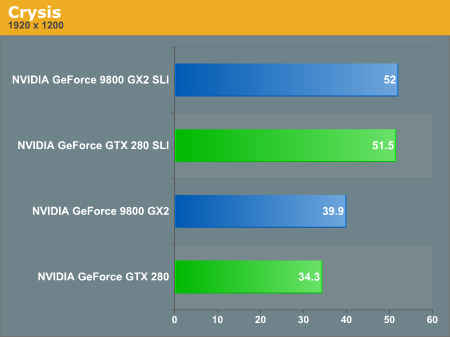
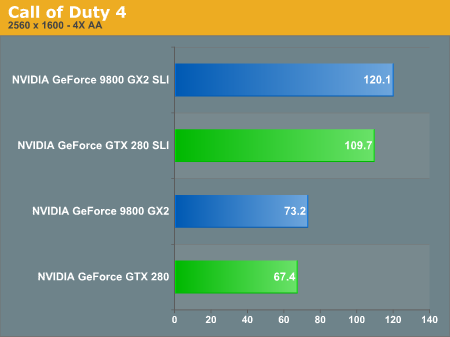

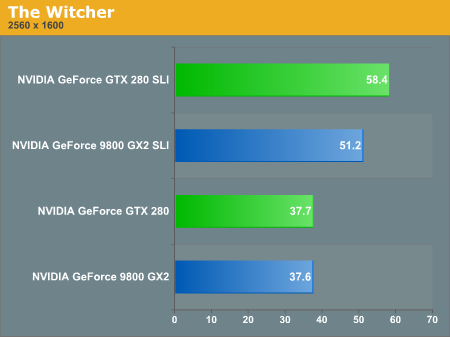
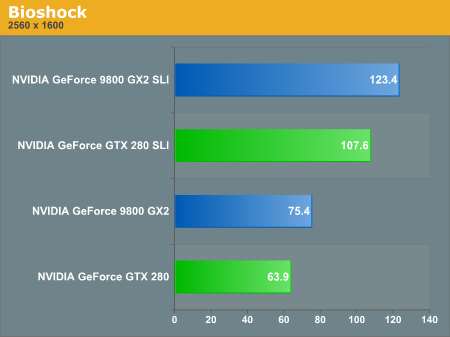
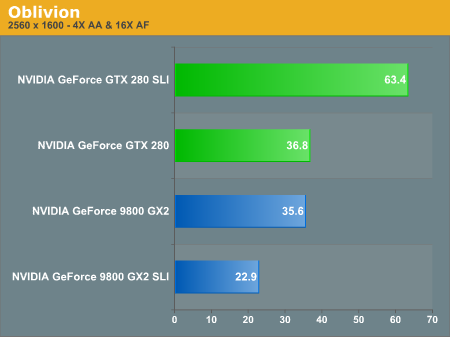








108 Comments
View All Comments
junkmonk - Monday, June 16, 2008 - link
I can has vertex data? LMFAO, hahha that was a good laugh.PrinceGaz - Monday, June 16, 2008 - link
When I looked at that, I assumed it must be a non-native English speaker who put that in the block. I'm still not entirely sure what it was trying to convey other than that the core will need to be fed with lots of vertices to keep it busy.Spoelie - Tuesday, June 17, 2008 - link
http://icanhascheezburger.com/">http://icanhascheezburger.com/http://icanhascheezburger.com/tag/cheezburger/">http://icanhascheezburger.com/tag/cheezburger/
chizow - Monday, June 16, 2008 - link
Its going to take some time to digest it all, but you two have done it again with a massive but highly readable write-up of a new complex microchip. You guys are still the best at what you do, but a few points I wanted to make:1) THANK YOU for the clock-for-clock comparo with G80. I haven't fully digested the results, but I disagree with your high-low increase thresholds being dependent on solely TMU and SP. You don't mention GT200 has 33% more ROP as well which I think was the most important addition to GT200.
2) The SP pipeline discussion was very interesting, I read through 3/4 of it and glanced over the last few paragraphs and it didn't seem like you really concluded the discussion by drawing on the relevance of NV's pipeline design. Is that why NV's SPs are so much better than ATI's, and why they perform so well compared to deep piped traditional CPUs? What I gathered was that NV's pipeline isn't nearly as rigid or static as traditional pipelines, meaning they're more efficient and less dependent on other data in the pipe.
3) I could've lived without the DX10.1 discussion and more hints at some DX10.1 AC/TWIMTBP conspiracy. You hinted at the main reason NV wouldn't include DX10.1 on this generation (ROI) then discount it in the same breath and make the leap to conspiracy theory. There's no doubt NV is throwing around market share/marketing muscle to make 10.1 irrelevant but does that come as any surprise if their best interest is maximizing ROI and their current gen parts already outperform the competition without DX10.1?
4) CPU bottlenecking seems to be a major issue in this high-end of GPUs with the X2/SLI solutions and now GT200 single-GPUs. I noticed this in a few of the other reviews where FPS results were flattening out at even 16x12 and 19x12 resolutions with 4GHz C2D/Qs. You'll even see it in a few of your benches at those higher (16/19x12) resolutions in QW:ET and even COD4 and those were with 4x AA. I'm sure the results would be very close to flat without AA.
That's all I can think of for now, but again another great job. I'll be reading/referencing it for the next few days I'm sure. Thanks again!
OccamsAftershave - Monday, June 16, 2008 - link
"If NVIDIA put the time in (or enlisted help) to make CUDA an ANSI or ISO standard extention to a programming language, we would could really start to get excited."Open standards are coming. For example, see Apple's OpenCL, coming in their next OS release.
http://news.yahoo.com/s/nf/20080612/bs_nf/60250">http://news.yahoo.com/s/nf/20080612/bs_nf/60250
ltcommanderdata - Monday, June 16, 2008 - link
At least AMD seems to be moving toward standardizing their GPGPU support.http://www.amd.com/us-en/Corporate/VirtualPressRoo...">http://www.amd.com/us-en/Corporate/VirtualPressRoo...
AMD has officially joined Apple's OpenCL initiative under the Khronos Compute Working Group.
Truthfully, with nVidia's statements about working with Apple on CUDA in the days leading up to WWDC, nVidia is probably on board with OpenCL too. It's just that their marketing people probably want to stick with their own CUDA branding for now, especially for the GT200 launch.
Oh, and with AMD's launch of the FireStream 9250, I don't suppose we could see benchmarks of it against the new Tesla?
paydirt - Monday, June 16, 2008 - link
tons of people reading this article and thinking "well, performance per cost, it's underwhelming (as a gaming graphics card)." What people are missing is that GPUs are quickly becoming the new supercomputers.ScythedBlade - Monday, June 16, 2008 - link
Lol ... anyone else catch that?Griswold - Monday, June 16, 2008 - link
Too expensive, too power hungry and according to other reviews, too loud for too little gain.The GT200 could become Nvidias R600.
Bring it on AMD, this is your big chance!
mczak - Monday, June 16, 2008 - link
G92 does not have 6 rop partitions - only 4 (this is also wrong in the diagram). Only G80 had 6.And please correct that history rewriting - that the FX failed against radeon 9700 had NOTHING to do with the "powerful compute core" vs. the high bandwidth (ok the high bandwidth did help), in fact quite the opposite - it was slow because the "powerful compute core" was wimpy compared to the r300 core. It definitely had a lot more flexibility but the compute throughput simply was more or less nonexistent, unless you used it with pre-ps20 shaders (where it could use its fx12 texture combiners).